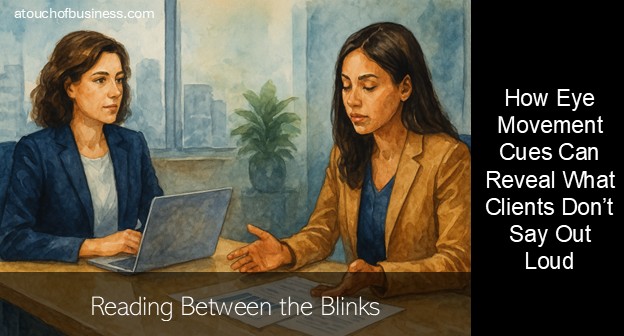Takeaways From Olivia’s Story
- How small eye movements can reveal hidden feelings in important meetings
- Why stopping to notice these cues builds trust and prevents mistakes
- Simple ways to spot and respond to what your client isn’t saying
Real trust starts when you listen with your eyes—not just your ears.
Reading Between the Blinks: What Eyes Say in a Meeting
Olivia sat in a quiet room at HorizonBridge Financial. Her laptop was open, notes ready.
It was just before 2 PM. She had a meeting with Jenna, a longtime client.
Jenna had built her agency from nothing. What started at her kitchen table had grown into a thriving team of twelve and a list of top-tier clients.
But this meeting wasn’t like the others.
Jenna had just landed two huge national deals. With that success, she wanted to open a second office.
Big Wins, Bigger Pressure
Jenna walked in, smiling, confident as ever. But Olivia noticed something beneath the surface.
Jenna rolled out her plans—market data, revenue charts, growth timelines—all sharp and on point.
“The numbers are solid,” she said, holding Olivia’s gaze. “We’re projecting a 26% jump in revenue. This is the right time.”
Olivia nodded. Jenna had clearly done her homework.
But things shifted when they moved to the financial details.
As Olivia brought up debt options on her screen, Jenna’s eyes dropped—down and to the left.
When they hit repayment terms, her eyes darted sideways, even though she kept nodding like all was fine.
What the Eyes Revealed
Olivia didn’t push forward with the deck. She closed her laptop, leaned back, and asked gently:
“Jenna, it seems like something’s on your mind. Want to talk it through plainly? No pressure today.”
Jenna’s shoulders dropped. Her whole body softened.
“Honestly,” she said, “I’m excited—but also scared. The numbers make sense. Strategically, this is the move. But taking on more debt after what we went through in COVID… it still haunts me. I’m afraid of losing everything we’ve built.”
Turning Fear into a Plan
That moment changed everything.
Instead of marching through her usual pitch, Olivia shifted gears. She focused on Jenna’s fears.
They spent the next hour building a safer path forward.
They looked at phased financing. They built in cushions for bumps along the way. They walked through backup plans to protect the core business.
“What if we don’t go all in at once?” Olivia asked. “We could try a smaller loan. Just enough to test the waters before diving in.”
By the end of the meeting, the plan felt less like a sale and more like teamwork.
Jenna left with a plan that matched both her goals and her comfort zone.
Why That Moment Mattered
Olivia didn’t win that meeting with numbers. She won it with awareness.
Jenna said she was ready. But her eyes told a deeper story.
When she looked down and left, she was likely recalling fear—the kind that stems from past pain.
When her eyes shifted sideways, she was torn—wanting to grow, but unsure if she could handle the risk.
By noticing these cues, Olivia gave Jenna what most advisors miss: space to be honest.
The Trust That Followed
That single meeting paid off long after it ended.
Three months later, Jenna’s new office opened ahead of schedule and under budget.
She referred two more business owners to Olivia. Not just because she was good with money—but because she understood people.
In finance, skill gets you in the door.
But empathy keeps clients coming back.
What Advisors Can Learn
Watching eye movements may sound odd. But it works.
Eyes give away what words sometimes hide.
- Looking down and left? That can mean someone’s tapping into an emotional memory. Maybe regret. Maybe fear.
- Looking sideways? Often a sign of conflict inside—logic saying “yes,” emotion whispering “no.”
- Even long eye contact can be misleading. Confident folks are great at masking stress.
What should you do?
Don’t act like a mind reader. Just notice. And then ask.
When you sense unease, pause. Give space. Let clients speak from the heart.
Because money isn’t just math. It’s wrapped up in fear, goals, loss, and hope.
Your Eyes Are Listening Too
- The best advisors aren’t just smart. They’re present.
- They don’t just deliver numbers. They build trust.
- They don’t just explain plans. They explore feelings.
- They listen with their ears—and their eyes.
And that’s what turns a meeting into a breakthrough.
Want to Try This? Start Here
Here are some basic eye movement signs to look for:
- Down and left: Emotional memory. The client might be thinking about a tough past event. Don’t push. Ask gently what’s on their mind.
- Side to side: Conflict. They might agree on the surface but feel unsure deep down. Dig in. Ask what’s not sitting right.
- Up and left: Visual recall. They’re trying to remember something. Give them space to think.
- Up and right: Imagination. They’re picturing a “what if” future. This is a great time to talk scenarios.
- Steady eye contact: May mean confidence—or a mask. If their body is tense or answers short, check in.
- No eye contact: Could be shame, fear, or discomfort. Show grace. Let them know you’re on their side.
Again—none of these are hard rules. But they’re good clues. Let them guide you, not define the client.
In Summary
Look at how people look—not just what they say.
When tension shows up, slow down. Ask questions. Listen with care.
Every big choice—career moves, new ventures, retirement—comes packed with emotion.
And those emotions don’t always speak out loud.
By tuning in to the subtle signs—especially eye movement—you can lead with more than facts.
You can lead with heart.

